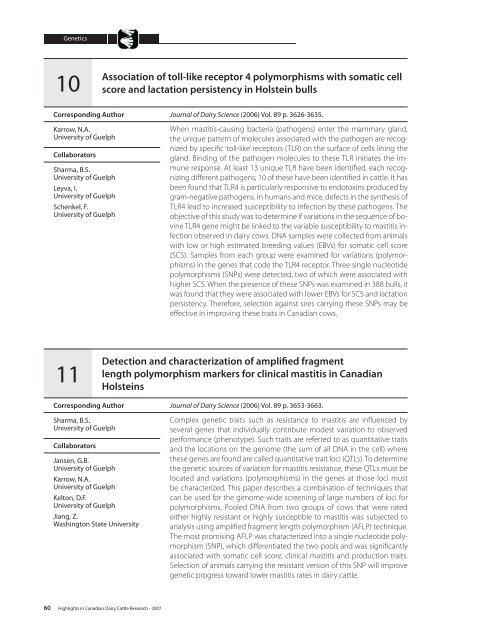A52-75-2007E.pdf - AgroMedia International Inc
A52-75-2007E.pdf - AgroMedia International Inc
A52-75-2007E.pdf - AgroMedia International Inc
Create successful ePaper yourself
Turn your PDF publications into a flip-book with our unique Google optimized e-Paper software.
Genetics10Association of toll-like receptor 4 polymorphisms with somatic cellscore and lactation persistency in Holstein bullsCorresponding AuthorKarrow, N.A.University of GuelphCollaboratorsSharma, B.S.University of GuelphLeyva, I.University of GuelphSchenkel, F.University of GuelphJournal of Dairy Science (2006) Vol. 89 p. 3626-3635.When mastitis-causing bacteria (pathogens) enter the mammary gland,the unique pattern of molecules associated with the pathogen are recognizedby specific ‘toll-like’ receptors (TLR) on the surface of cells lining thegland. Binding of the pathogen molecules to these TLR initiates the immuneresponse. At least 13 unique TLR have been identified, each recognizingdifferent pathogens; 10 of these have been identified in cattle. It hasbeen found that TLR4 is particularly responsive to endotoxins produced bygram-negative pathogens. In humans and mice, defects in the synthesis ofTLR4 lead to increased susceptibility to infection by these pathogens. Theobjective of this study was to determine if variations in the sequence of bovineTLR4 gene might be linked to the variable susceptibility to mastitis infectionobserved in dairy cows. DNA samples were collected from animalswith low or high estimated breeding values (EBVs) for somatic cell score(SCS). Samples from each group were examined for variations (polymorphisms)in the genes that code the TLR4 receptor. Three single nucleotidepolymorphisms (SNPs) were detected, two of which were associated withhigher SCS. When the presence of these SNPs was examined in 388 bulls, itwas found that they were associated with lower EBVs for SCS and lactationpersistency. Therefore, selection against sires carrying these SNPs may beeffective in improving these traits in Canadian cows.11Detection and characterization of amplified fragmentlength polymorphism markers for clinical mastitis in CanadianHolsteinsCorresponding AuthorSharma, B.S.University of GuelphCollaboratorsJansen, G.B.University of GuelphKarrow, N.A.University of GuelphKelton, D.F.University of GuelphJiang, Z.Washington State UniversityJournal of Dairy Science (2006) Vol. 89 p. 3653-3663.Complex genetic traits such as resistance to mastitis are influenced byseveral genes that individually contribute modest variation to observedperformance (phenotype). Such traits are referred to as quantitative traitsand the locations on the genome (the sum of all DNA in the cell) wherethese genes are found are called quantitative trait loci (QTLs). To determinethe genetic sources of variation for mastitis resistance, these QTLs must belocated and variations (polymorphisms) in the genes at those loci mustbe characterized. This paper describes a combination of techniques thatcan be used for the genome-wide screening of large numbers of loci forpolymorphisms. Pooled DNA from two groups of cows that were ratedeither highly resistant or highly susceptible to mastitis was subjected toanalysis using amplified fragment length polymorphism (AFLP) technique.The most promising AFLP was characterized into a single nucleotide polymorphism(SNP), which differentiated the two pools and was significantlyassociated with somatic cell score, clinical mastitis and production traits.Selection of animals carrying the resistant version of this SNP will improvegenetic progress toward lower mastitis rates in dairy cattle.60 Highlights in Canadian Dairy Cattle Research - 2007





